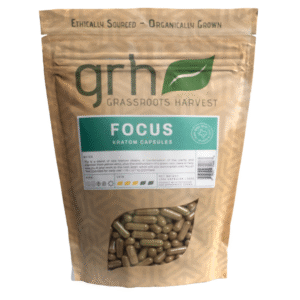It’s no secret that headaches are the worst. They, like the worst guest, show up unannounced, have little known reason for existence, and rarely leave without taking something from you. So, to relieve the stress, you take some medication you can barely pronounce and do not understand. That’s why so many Americans are turning to alternatives, like kratom.
In this lively discussion, we’ll dive into the brain-bending saga of Kratom, unraveling whether it’s the hero or the villain in the story of migraines. Spoiler alert: it’s a bit of both. We’ll explore how Kratom plays hopscotch with your neurons, sometimes soothing those pesky migraines and other times, well, not so much. Plus, we’ve got tips on sidestepping those headache hurdles and where to find Kratom that’s so good, it might just make your head spin – but in a good way. So, grab your favorite mug, and let’s spill the tea on all things Kratom and headaches!
Now that we’ve set the stage with our head-spinning (in a good way) introduction, let’s delve deeper into the cerebral world of Kratom. At its core, Kratom contains a plethora of active compounds, primarily mitragynine and 7-hydroxymitragynine. These compounds interact with the brain’s opioid receptors, but before you raise an eyebrow, it’s not quite what you think. Unlike traditional opioids, Kratom’s interaction is more of a gentle nudge than a full-on embrace, which accounts for its unique effects.
These compounds can play a significant role in how we experience headaches and migraines. For some, Kratom acts like a soothing balm, easing the tension and throbbing associated with migraines. This is likely due to its analgesic properties, which help dampen the body’s discomfort signals. On the other hand, in certain scenarios, Kratom can be like that uninvited guest who makes the head-pounding worse, possibly due to its stimulating effects at lower doses or when used excessively.
Understanding this delicate balance is key to using Kratom effectively for headaches. It’s like finding the perfect temperature in a shower – too hot or too cold, and it’s not pleasant. This section aims to shed light on this balancing act, offering insights into how Kratom’s unique chemistry interacts with our complex brain, influencing our experiences with headaches and migraines.
Having talked about the neural pathways of Kratom’s interaction with the brain, it’s time to tackle a more direct question: does Kratom play a role in soothing or stimulating headaches? This section peers into the dualistic nature of Kratom, akin to a coin with two very different sides.
On one side, research hints at Kratom’s potential to offer relief from the symptoms of headaches and migraine discomfort. This is primarily attributed to its analgesic properties, which work to reduce the intensity of discomfort signals. For many, this can mean the difference between a day lost under the covers and one spent in relative comfort. Kratom’s calming effects on the nervous system might also contribute to alleviating the sensory overload often experienced during a migraine.
Flip the coin, and we find instances where Kratom might exacerbate headache symptoms. This is particularly evident in cases of overuse or in individuals with a sensitivity to Kratom’s more stimulating compounds.
To understand Kratom’s relationship with migraines and headaches, it’s essential to consider its stimulant properties. Mitragyna speciosa, the botanical name for Kratom, shares family ties with the coffee plant, a well-known stimulant. This kinship suggests that Kratom, like your daily cup of coffee, may have energizing effects due to similar compounds.
However, this stimulation can be a double-edged sword. For regular users of Kratom, especially those seeking an energy boost, the experience can be akin to consuming multiple cups of coffee. This can lead to headaches, similar to the caffeine-induced ones familiar to coffee enthusiasts. Additionally, symptoms like nausea and dizziness, often associated with stimulants, may also occur with Kratom, particularly when used in higher doses or frequently.
While some early research showed promise for Kratom as an alternative to traditional relief methods, the conclusions remain mixed. The interplay of Kratom with prescription medications is an area of particular concern. It’s suggested that in such combinations, Kratom might trigger adverse neurological effects, including severe headaches, communication difficulties, or disorientation.
The key here is understanding dosage and body chemistry, as what provides relief for one might spell trouble for another.
As we’ve explored the complex relationship between Kratom and headaches, it’s clear that a thoughtful approach to its use is essential. To enjoy the benefits of Kratom while minimizing the risk of headaches, consider these proactive strategies.
By incorporating these strategies into your Kratom routine, you can create a more enjoyable and headache-free experience. Remember, responsible use is key to harnessing the full potential of Kratom, ensuring both safety and satisfaction in your wellness journey.
So, we’ve journeyed through the highs and (head)lows of Kratom, and now it’s time to wrap things up with a bow made of quality leaves – metaphorically speaking, of course. Choosing high-quality Kratom isn’t just about avoiding the dreaded head-throb; it’s about enjoying your botanical buddy to the fullest. Think of it like picking the ripest, juiciest fruit from the tree – it just makes everything better!
Our store is like a treasure chest of top-tier Kratom. We’ve done all the hard work, ensuring each leaf is as good as a Kratom leaf can get. So, if you’re keen on keeping those pesky headaches at bay and riding the Kratom wave like a pro, give us a visit. We’re committed to making your Kratom experience headache-free and happy. After all, life’s too short for bad Kratom and unnecessary headaches!



